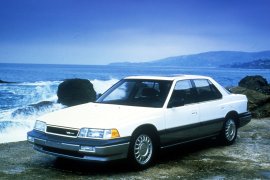ACURA Legend Models/Series Timeline, Specifications & Photos
First production year: 1986
Engines: Gasoline
Built as a competitor in the premium market, the second generation of the Acura Legend made its debut in October 1990. It was the flagship of the Honda company.
The 1990 Acura Legend was introduced with the direct aim of the BMW and Mercedes-Benz. Even if it didn't offer more engine choices, it had features hard to imagine on a car from that year. After the year 2000, features like the in-car telephone was something quite often found in a premium sedan. But in 1990 there were just a few, and the Legend was one of them.
The long silhouette with a low beltline suggested that the car was rear-wheel-drive. The flat hood and narrow front side with rectangular headlights were achieved thanks to a longitudinally mounted engine. Most of the front-wheel-drive vehicles already switched to transversal engines and gearbox, but that would make the front side taller. The narrow grille design of the Legend and the sleek overall look was appreciated by its customers.
Inside, the Acura Legend offered electronic climate control, on-board computer, a telephone, and even soft-close pneumatic system. It was something that most of the more expensive vehicles didn't have on the options list.
Under the hood, the Legend featured a 3.2-liter V6 engine. It was mated to a standard 5-speed manual or a 4-speed automatic. In fact, the gearbox and the paint were the only options on the Legend's list.
Honda took a decisive step to create a premium brand for the American car market, and one of the first products was the 1986 Legend sports sedan.
The Japanese automakers were not allowed to export as many cars as they wished in the U.S., so Honda found a way to profit more from its vehicles: selling them as a premium brand with a higher margin. That's how the Acura brand was created, and the automaker scored big with the Legend.
Designed as a four-door sedan but with a few sporty touches, the Legend wasn't the regular Accord the Americans already knew. Instead, its design was bold, with squared headlights and flared fenders that gave the car a sportier look. In addition, by placing double-wishbone suspension up front, Honda was able to create a lower hood line. Furthermore, the automaker added a few chromed lines along the bodywork and around the grille, giving the car a stylish look. Strangely, though, there was no badge on the grille.
Thanks to its long wheelbase, the car's interior was fit for five adults. Here, the automaker used higher-grade materials, so customers could feel better why this Legend was not exactly a regular Honda product and why it was much more expensive than an Accord. The Legend featured power windows and locks, power sunroof, a stereo cassette player with equalizer, cruise control, and tilt steering wheel.
Power came from a 2.5-liter V6 with four valves per cylinder. For that time, this was a major technological achievement. The oomph went to the front wheels via a four-speed automatic or a five-speed manual.

